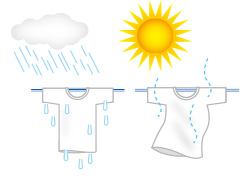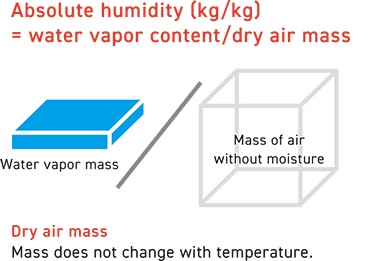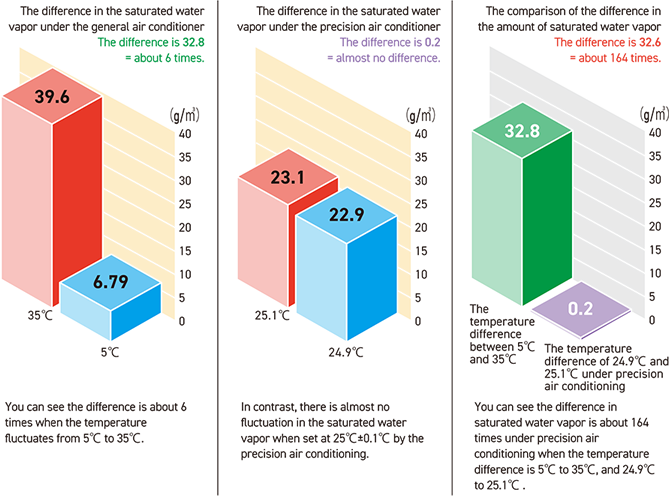Control Panel Cooling units Technical Information
1-4. The principles of temperature and humidity
This section explains the temperature change and humidity/dryness.
(1) Controlling humidity in the atmosphere is essential to hastening or keeping a dry state.
Objects that contain moisture change their characteristics depending on their moisture content.
The change in characteristics caused by the change in moisture content has a great impact on the quality of products in the manufacturing field.
Drying is the phenomenon of being in a dry state by evaporating moisture from wet objects. The more saturated water vapor in the air (the amount of water vapor that can exist in the atmosphere) and the lower the water content, the water easily evaporate and of object dries out.
In this chapter, it summarizes the relationship between temperature and saturated water vapor content and simulates and compares the moisture content that is contained in the atmosphere under general air conditioning and precision air conditioning.
* The dryness velocities are different depending on the moisture content ratio, in this chapter, the moisture content is not discussed.

(2) Even though the air contains the same amount of moisture, the (relative) humidity gets higher as the temperature drops.
Humidity is the water vapor content and rate in the atmosphere.
There is absolute humidity and relative humidity in humidity, relative humidity is commonly used in weather forecasts.
Relative humidity
Relative humidity (RH) is the ratio that water vapor content (mw) in atmosphere at a temperature is divided by the saturated water vapor (mmax) of its humidity.
RH(%)=mw/mmax×100
When the relative humidity is 100%, the water vapor content in the atmosphere is saturated, and dew condensation occurs.
The temperature at that time is called the "dew point temperature."

Absolute humidity
There are volumetric humidity and humidity ratios in absolute humidity, and the humidity ratio is commonly used in the air conditioning field.
The air that contains water vapor is called moist air, and the air that has removed the water vapor from moist air is called dry air.
The humidity ratio (SH) (kg/kg) is the ratio of water vapor weight mw (kg) in moist air, contrary to the dry air weight mDA (kg).
Absolute humidity (kg/kg) = water vapor content/dry air mass

(3) Temperature and humidity
"The amount of saturated water vapor" that changes significantly depending on the temperature
The amount of saturated water vapor
The amount of saturated water vapor a(T) (g/㎥) is the water vapor content that exists in 1㎥ of atmospheric air and is expressed by mass (g).
The amount of saturated water vapor is strongly related to temperature, the higher the temperature, the higher the amount, and the lower the temperature, the lower the amount.
Approximately calculate as follows:
a(T)=(217×e(T))/(T+273.15)
e(T),e(T)=6.1078×10^(7.5T/(T+237.3))
* Omit the calculation of the proximate critical pressure (=22.12MPa).
The critical pressure is the essential pressure to liquidate gases at their proximate critical temperature.

(4) The simulation of saturated water vapor
Precision air conditioning that maintains not only temperature but also constant humidity and saturated water vapor throughout the year
Temperature fluctuates from 5℃ to 35℃ through a year, and this is the result below that substitutes temperature into the previous formula when the temperature is controlled at 25℃±0.1℃ under precision air conditioning.

By keeping the temperature constant throughout the year, it is also possible to keep the saturated water vapor stable.
* The temperature difference (5℃ to 35℃) above may be caused throughout the year by a lack of cooling capacity or such, depending on where the air conditioner is located under general air conditioning.
The dry amount of moisture changes with the amount of saturated water vapor in the object's surrounding environment.
Stabilizing saturated water vapor by keeping the temperature constant is related to stabilizing the dry amount of moisture.
Wind
As the element of "drying," "wind" is also another factor.
By applying dry air to objects' surfaces evenly, drying can be sped up.
As long as there is water vapor or saturated air adhering to the surface, it protect drying.
Using this principle, it is possible to control the amount of dryness in moisture.
Previous item: 1-3. Cooling principles
Next item: 2-1. The refrigerant cycle
We're here to give you quick answers to your questions.
